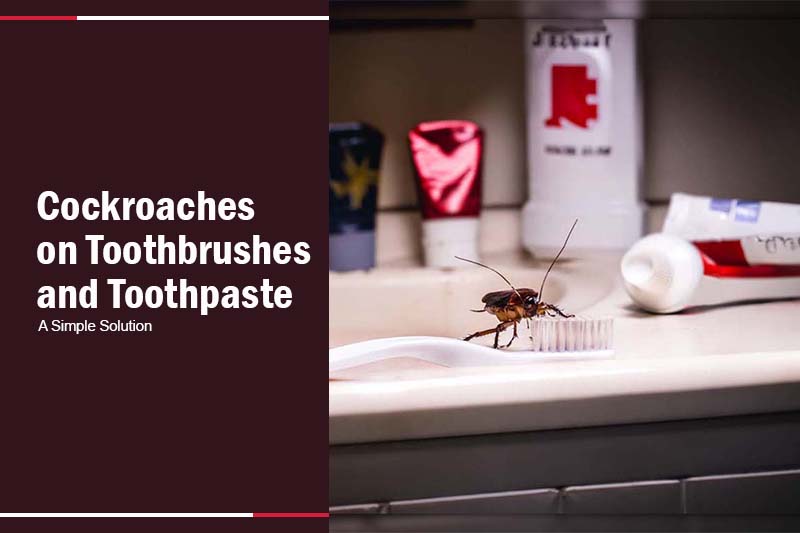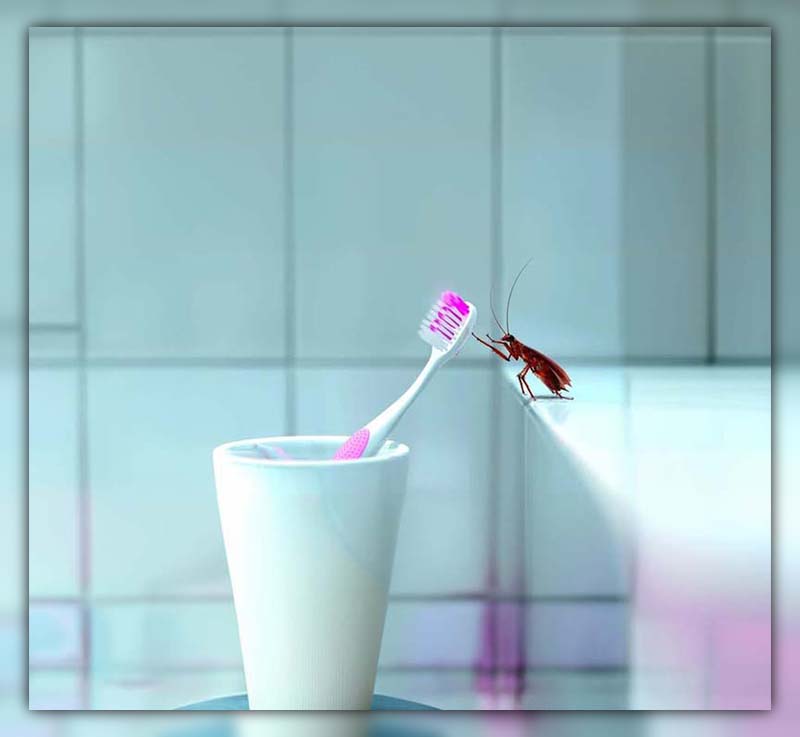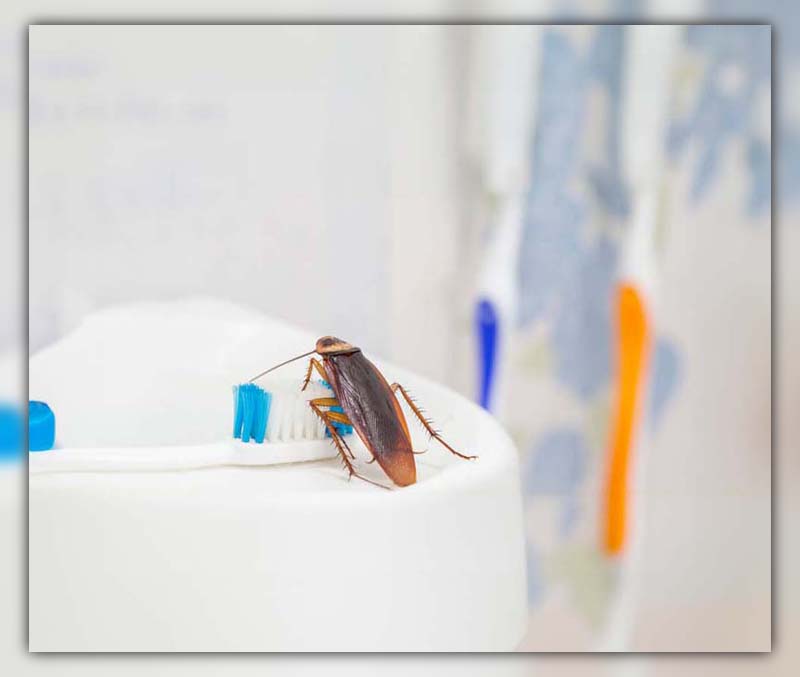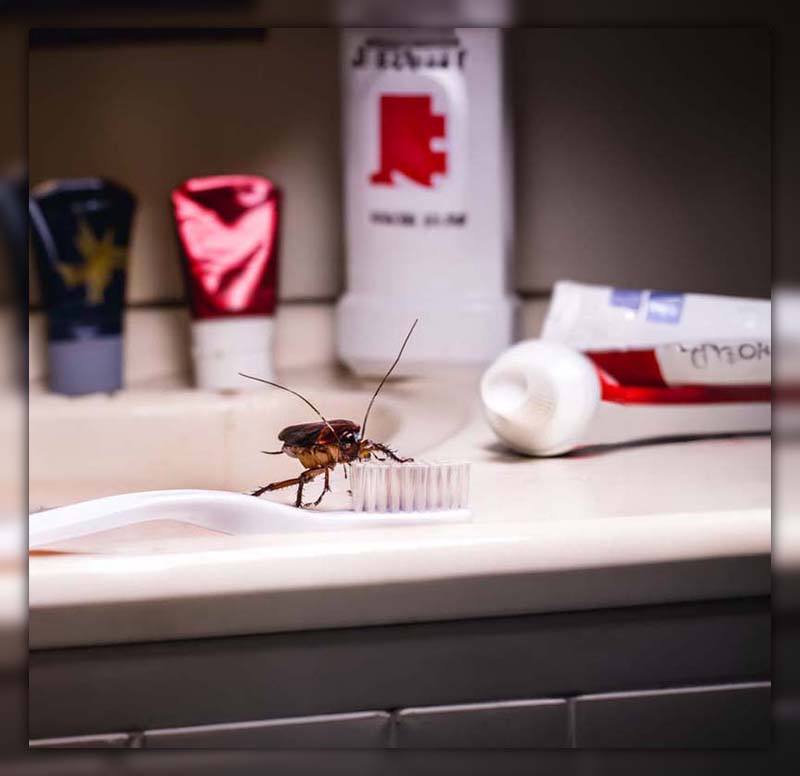Imagine waking up in the morning and finding a cockroach on toothbrush or toothpaste. How would you feel?
If you have ever experienced this nightmare scenario or want to avoid it, then this blog is for you.

Can toothpaste kill roaches?
Toothpaste can kill roaches if they eat it in large quantities because it contains fluoride. When they consume fluoride, it will mix with fluids in them and release hydrogen fluoride (HF).
HF is an acid that can cause internal burns in a roach which can kill them when a good amount is consumed.
Even though hydrogen fluoride in toothpaste is classified under acids that are not very strong, it can affect roaches.
It gives off ions just like any other acid which is enough to dissolve the bugs’ internal cells. A toothpaste’s fatality rate on roaches will depend on the type and amounts consumed.
>> Read more: What do roaches smell like?

How to keep roaches off toothbrush?
Keep cockroaches from your toothbrush by washing its bristles with plenty of warm water after use. Store it in a closed ventilated toothbrush holder. If cockroaches crawl on your brush, combine 1/2 cup of water with 1 teaspoon of baking soda. Then soak the toothbrush in it for 15-30minutes to disinfect it.
Watch how you keep your toothbrush because keeping it in a closed holder that is an airtight holder can encourage mold. Using a mold-infested brush daily can result in unwanted infections. A closed holder protects your brush from roaches but leaves it with high chances of mold at the bristles’ base.
Avoid keeping your brush close to the toilet seat, as bugs, including cockroaches, sometimes infest those areas. Cockroaches can hide in toilet bowls and come out when looking for alternative food sources. If your brush is kept near the toilet seat, they may crawl on it and consume toothpaste residues.
>> Read more: Difference between beetle and cockroach: Quick Guide to Spot the Difference.
Keep it dry and clean
Keeping your toothbrush clean and dry is not only important for your oral hygiene, but also for preventing cockroach infestation.
Cockroaches drink water to survive, and they are attracted to moist and humid places, such as your toothbrush.
If you leave your toothbrush constantly damp, you may invite roaches and other bacterial infections. Here are some tips to keep your toothbrush safe from roaches:
- After using your toothbrush, wash it thoroughly and keep it in a well-ventilated area. Position it in a cup in a way that the bristles are facing up so that it can dry faster. Leave it near the bathroom window or open space so that air can circulate in the bristles.
- Consider keeping your toothbrush away from the bathroom if there is poor air circulation or high humidity. Find a good position in your bedroom or anywhere else in the house where the brush can be easily accessible and well aerated. You can also use a portable fan or a hair dryer to speed up the drying process.
- In case you want a cockroach-proof brush holder, get one that is well aerated and has a lid or a cover. This will prevent roaches from crawling into your brush holder and contaminating your toothbrush. You can also sprinkle some borax or boric acid around your brush holder to repel roaches.

What if a cockroach crawls on your toothbrush?
Once you confirm that a roach has crawled on your brush, pour 2 ounces of mouthwash into a cup. Dip the toothbrush into the cup and fill it with hot water until the bristles are covered. Let it soak for at least 30 minutes or more. Then remove, rinse and let it dry naturally in a well-ventilated area.
If you do not have any mouthwash in the house, you can use baking soda for roaches. Simply soak the toothbrush in 1 tablespoon of baking soda, 1/2 spoon of white vinegar, and 1/2 cup of water for 30-60 minutes. You may also let it sit in the solution overnight if there is no agency.
Do not forget to always rinse your brush with plenty of water before use. This helps in removing germs or infections from bugs or fruit flies in the bathroom that land on it. If possible, wash your toothbrush at least 2-3 times a week with hot water salty water to disinfect it.
Some people may opt for throwing away a toothbrush that a roach has crawled on. Well, this can also work but what if your storage area is infested and roaches crawl on your brush daily? This can end up being costly because you may have to buy new brushes every other day.
Roaches on your toothbrush may possibly leave traces of their saliva and stools on the bristles. Based on a study by the EPA on roach contamination, those bugs can transmit bacteria like salmonella which can cause diarrhea and stomach upsets. This is why you should never use any toothbrush if you roaches on it.
>> Read more: Do roaches need water? The Truth May Shock You.

Conclusion
In this blog, you have learned the answer to the question: cockroach on toothbrush and toothpaste? You have discovered some useful tips and tricks to keep your toothbrush and toothpaste clean and cockroach-free.
We hope you found this blog helpful and informative. If you want to learn more about cockroaches and how to deal with them, check out our other blogs from Pestweek.

Calina Mabel has over 15 years of experience in the field of journalism and communications. Currently, Calina Mabel is the Content Writer for categories such as Cockroach, Ants, Bed Bugs, Mosquito, Rodent, Termite, and Flies on Pestweek.com. She aims to build content for these categories with a focus on providing valuable and accessible information to readers, in order to create the world’s largest knowledge community about Pests.
All content written by Calina Mabel has been reviewed by Emily Carter.

